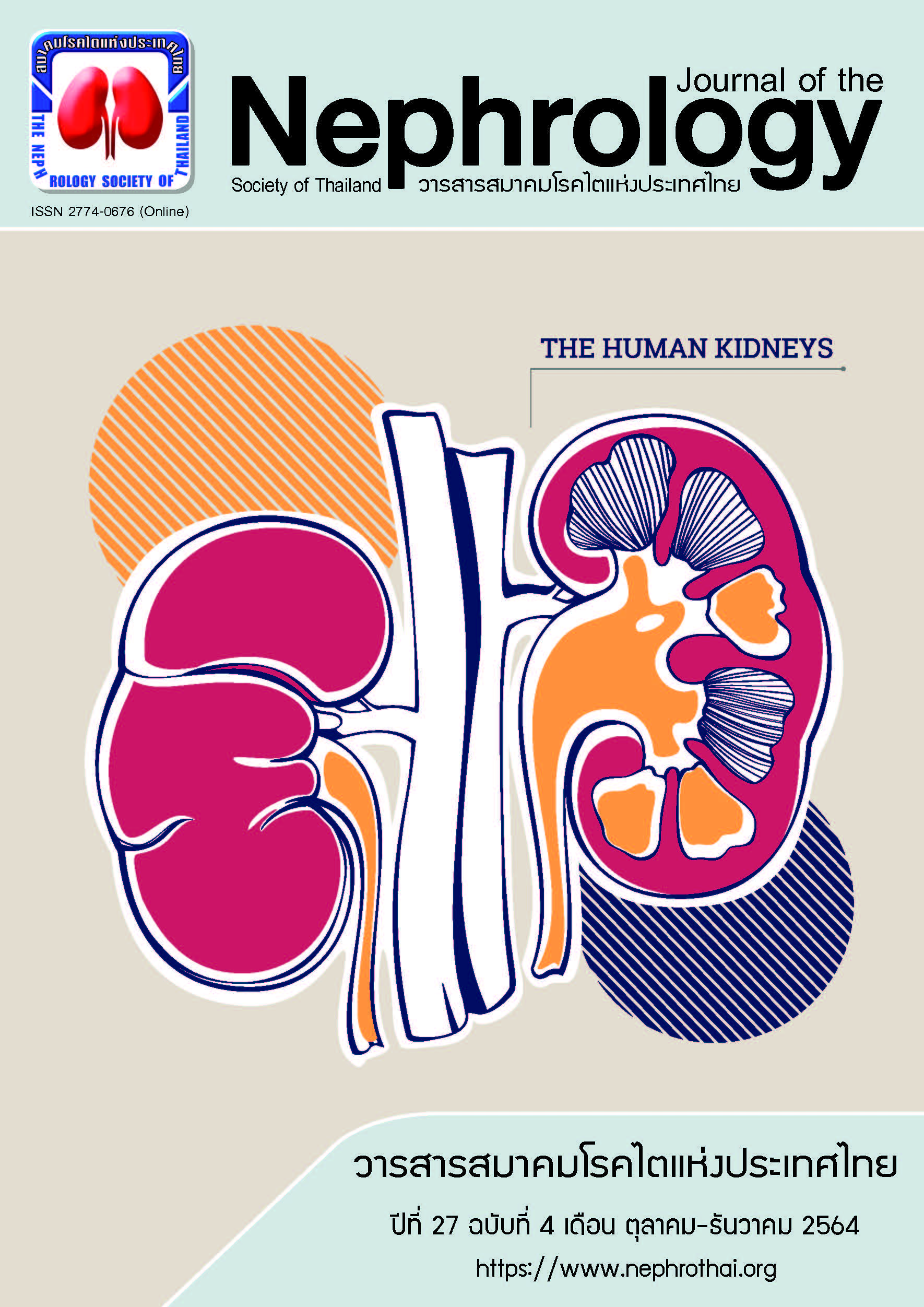ภาวะสูญเสียมวลกล้ามเนื้อในผู้ป่วยโรคไตเรื้อรัง
Main Article Content
บทคัดย่อ
ภาวะสูญเสียมวลกล้ามเนื้อเป็นปัญหาสำคัญที่พบมากขึ้นในปัจจุบันของผู้ป่วยโรคไตเรื้อรัง และเป็นสาเหตุของทุพพลภาพและเสียชีวิตของผู้ป่วย โดยมีสาเหตุหลักจากการเปลี่ยนแปลงทางระบบฮอร์โมนและการอักเสบในร่างกายจากภาวะไตเรื้อรัง ส่งผลต่อการใช้พลังงานระดับเซลล์ ทำให้การสร้างโปรตีนในกล้ามเนื้อลดลงและเพิ่มการสลายตัวของกล้ามเนื้อ คำจำกัดความของภาวะสูญเสียมวลกล้ามเนื้อ คือ ความแข็งแรงร่วมกับปริมาณและคุณภาพของมวลกล้ามเนื้อที่ลดลง จนส่งผลต่อสมรรถภาพทางกาย การวินิจฉัยอาศัยการซักประวัติ การตรวจร่างกาย และตรวจเพิ่มเติมทางรังสีวิทยา เช่น การใช้ภาพตัดขวางของกล้ามเนื้อ มวลกล้ามเนื้อรยางค์จากเครื่องตรวจวัดความหนาแน่นของมวลกระดูก ร่วมกับการวัดการทำงานของกล้ามเนื้อ เช่น การทดสอบอัตราเร็วในการเดิน และการวัดกำลังการบีบมือ หลักการป้องกันและรักษาภาวะนี้เน้นถึงการออกกำลังกาย การให้โภชนบำบัด การแก้ไขภาวะเลือดเป็นกรด การให้ฮอร์โมนทดแทน และยาที่ไปยับยั้งการสลายตัวของกล้ามเนื้อ ซึ่งอาจป้องกันภาวะแทรกซ้อนจากภาวะการสูญเสียมวลกล้ามเนื้อได้
Article Details

This work is licensed under a Creative Commons Attribution-NonCommercial-NoDerivatives 4.0 International License.
บทความนี้ตีพิมพ์ภายไต้การอนุญาต CC BY-NC-ND 4.0 ซึ่งอนุญาตให้สามารถใช้บทความนี้พื่อวัตถุประสงค์ใดๆ ก็ตามที่ไม่ใช่เชิงพาณิชย์ โดยต้องมีการอ้างถึงที่มาของบทความอย่างครบถ้วน ใครก็ตามสามารถคัดลอกและแจกจ่ายทุกส่วนของบทความนี้โดยไม่ต้องขออนุญาตจากผู้ประพันธ์หรือสมาคมโรคไตแห่งประเทศไทย
References
Von Haehling S, Morley JE, Anker SD. An overview of sarcopenia: facts and numbers on prevalence and clinical impact. J Cachexia Sarcopenia Muscle 2010; 1:129–133.
Ong-Ajyooth L, Vareesangthip K, Khonputsa P, Aekplakorn W. Prevalence of chronic kidney disease in Thai adults: a national health survey. BMC Nephrol. 2009; 10:35.
Stenvinkel P, Carrero JJ, von Walden F, Ikizler TA, Nader GA. Muscle wasting in end-stage renal disease promulgates premature death: established, emerging and potential novel treatment strategies. Nephrol Dial Transplant. 2016;31(7):1070-7.
Diesel W, Emms M, Knight BK, Noakes TD, Swanepoel CR, van Zyl Smit R, et al. Morphologic features of the myopathy associated with chronic renal failure. Am J Kidney Dis 1993; 22:677-84.
Mahesh S, Kaskel F. Growth hormone axis in chronic kidney disease. Pediatr Nephrol 2008; 23:41-8.
Phillips SK, Gopinathan J, Meehan K, Bruce SA, Woledge RC. Muscle strength changes during the menstrual cycle in adductor pollicis. J Physiol 1993; 473:125P.
Wang X, Hu Z, Hu J, Du J, Mitch WE. Insulin resistance accelerates muscle protein degradation: Activation of the ubiquitin-proteasome pathway by defects in muscle cell signaling. Endocrinology 2006; 147: 4160-8.
Fahal IH, Bell GM, Bone JM, Edwards RH. Physiological abnormalities of skeletal muscle in dialysis patients. Nephrol Dial Transplant 1997; 12:119-27.
Gilson H, Schakman O, Kalista S, Lause P, TsuchidaK, Thissen JP. Follistatin induces muscle hypertrophy through satellite cell proliferation and inhibition of both myostatin and activin. Am J Physiol Endocrinol Metab 2009; 297:E157-64.
Siami G, Clinton ME, Mrak R, et al. Evaluation of the effect of intravenous L-carnitine therapy on function, structure and fatty acid metabolism of skeletal muscle in patients receiving chronic hemodialysis. Nephron 1991; 57:306.
Fahal IH. Uraemic sarcopenia: aetiology and implications. Nephrol Dial Transplant 2014; 29: 1655-65.
Workeneh BT, Mitch WE. Review of muscle wasting associated with chronic kidney disease. Am J Clin Nutr 2010; 91:1128S-1132S.
Roshanravan B, Kestenbaum B, Gamboa J, et al. CKD and Muscle Mitochondrial Energetics. Am J Kidney Dis 2016; 68:658.
Bailey JL, Zheng B, Hu Z, Price SR, Mitch WE. Chronic kidney disease causes defects in signaling through the insulin receptor substrate/phosphatidylinositol3- kinase/Akt pathway: implications for muscle atrophy. J Am Soc Nephrol 2006; 17: 1388- 94.
Cohn RD, van Erp C, Habashi JP, Soleimani AA, Klein EC, Lisi MT, et al. Angiotensin II type 1 receptor blockade attenuates TGF-beta-induced failure of muscle regeneration in multiple myopathic states. Nat Med 2007; 13:204-10.
Kaizu Y, Ohkawa S, Odamaki M, Ikegaya N, Hibi I, Miyaji K, et al. Association between inflammatory mediators and muscle mass in long-term hemodialysis patients. Am J Kidney Dis 2003; 42:295-302.
Campistol JM. Uremic myopathy. Kidney Int 2002; 62:1901.
Diesel W, Emms M, Knight BK, et al. Morphologic features of the myopathy associated with chronic renal failure. Am J Kidney Dis 1993; 22:677.
Cruz-Jentoft AJ, Bahat G, Bauer J, Boirie Y, Bruyere O, Cederholm T, et al. Sarcopenia: revised European consensus on definition and diagnosis. Age Ageing. 2019; 48(1):16-31.
Johansen KL. Exercise in the end-stage renal disease population. J Am Soc Nephrol 2007; 18:1845.
Fiatarone MA, O’Neill EF, Ryan ND, et al. Exercise training and nutritional supplementation for physical frailty in very elderly people. N Engl J Med 1994; 330:1769.
Hewitt NA, O’Connor AA, O’Shaughnessy DV, Elder GJ. Effects of cholecalciferol on functional, biochemical, vascular, and quality of life outcomes in hemodialysis patients. Clin J Am Soc Nephrol 2013; 8:1143.
Caglar K, Fedje L, Dimmitt R, Hakim RM, Shyr Y, Ikizler TA. Therapeutic effects of oral nutritional supplementation during hemodialysis. Kidney Int 2002; 62:1054-9.
Moorthi RN, Avin KG. Clinical relevance of sarcopenia in chronic kidney disease. Curr Opin Nephrol Hypertens. 2017; 26(3):219-28

